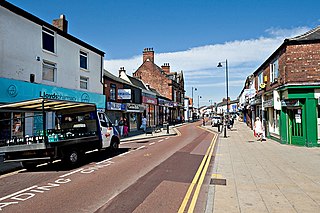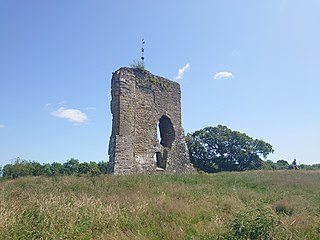The General Assembly of Unitarian and Free Christian Churches is the umbrella organisation for Unitarian, Free Christians, and other liberal religious congregations in the United Kingdom and Ireland. It was formed in 1928, with denominational roots going back to the Great Ejection of 1662. Its headquarters is Essex Hall in central London, on the site of the first avowedly Unitarian chapel in England, set up in 1774.

Atherton is a town in the Metropolitan Borough of Wigan in Greater Manchester, England and historically part of Lancashire. The town, including Hindsford, Howe Bridge and Hag Fold, is 5 miles (8.0 km) south of Bolton, 7 miles (11.3 km) east of Wigan, and 10 miles (16.1 km) northwest of Manchester. From the 17th century, for about 300 years, Atherton was known as Chowbent, which was frequently shortened to Bent, the town's old nickname. During the Industrial Revolution, the town was a key part of the Manchester Coalfield.
Gundred or Gundreda was the Flemish-born wife of an early Norman baron, William de Warenne, 1st Earl of Surrey. She and her husband established Lewes Priory in Sussex.

Joseph Hunter was a Unitarian Minister, antiquarian, and deputy keeper of public records now best known for his publications Hallamshire. The History and Topography of the Parish of Sheffield in the County of York, the two-volume South Yorkshire , still considered among the best works written on the history of Sheffield and South Yorkshire, and his 1852 pamphlet on Robin Hood in which he argued that a servant of this name at the court of Edward II was identical with the famous outlaw. His name was adopted by the Hunter Archaeological Society.

George O'Brien Wyndham, 3rd Earl of EgremontFRS of Petworth House in Sussex and Orchard Wyndham in Somerset, was a British peer, a major landowner and a great art collector. He was interested in the latest scientific advances. He was an agriculturist and a friend of the agricultural writer Arthur Young, and was an enthusiastic canal builder who invested in many commercial ventures for the improvement of his estates. He played a limited role in politics.

The medieval Knepp Castle is to the west of the village of West Grinstead, West Sussex, England near the River Adur and the A24.
Sir George Shiffner, 1st Baronet, was a British politician.

William Reade or William Rede (c.1315-1385) was a medieval bishop, theologian and astronomer.
Sir Richard Sackville of Ashburnham and Buckhurst in Sussex and Westenhanger in Kent; was an English administrator and Member of Parliament.

Chowbent Chapel is an active Unitarian place of worship in Atherton, Greater Manchester, England. It was built in 1721 and is the oldest place of worship in the town. It is a member of the General Assembly of Unitarian and Free Christian Churches, the umbrella organisation for British Unitarians. The chapel was granted Grade II* Listed status in 1966.
Joseph Nightingale was a prolific English writer and preacher. He was particularly noted for his topographic writing and his interest in shorthand.
William Levett was an English clergyman. An Oxford-educated country rector, he was a pivotal figure in the use of the blast furnace to manufacture iron. With the patronage of the English Crown, furnaces in Sussex under Levett's ownership cast the first iron muzzle-loader cannons in England in 1543, a development which enabled England to ultimately reconfigure the global balance-of-power by becoming an ascendant naval force. William Levett continued to perform his ministerial duties while building an early munitions empire, and left the riches he accumulated to a wide variety of charities at his death.

James Wood (1672–1759) was a Presbyterian minister of the first Atherton and Chowbent Chapels in Atherton, Greater Manchester, England. During the Jacobite rising, he was given the title "the General" for leading a force of men that routed the Highlanders.
Combe Miller was a Church of England clergyman. He was the third son of Sir John Miller, 4th Baronet Miller of Froyle and Susan Combe.
English county histories, in other words historical and topographical works concerned with individual ancient counties of England, were produced by antiquarians from the late 16th century onwards. The content was variable: most focused on recording the ownership of estates and the descent of lordships of manors, thus the genealogies of county families, heraldry and other antiquarian material. In the introduction to one typical early work of this style, The Antiquities of Warwickshire published in 1656, the author William Dugdale writes:
I offer unto you my noble countriemen, as the most proper persons to whom it can be presented wherein you will see very much of your worthy ancestors, to whose memory I have erected it as a monumentall pillar and to shew in what honour they lived in those flourishing ages past. In this kind, or not much different, have divers persons in forrein parts very learnedly written; some whereof I have noted in my preface: and I could wish that there were more that would adventure in the like manner for the rest of the counties of this nation, considering how acceptable those are, which others have already performed
William Durrant Cooper (1812–1875) was an English lawyer and antiquary.

St Mary Our Lady is the parish church of Sidlesham in West Sussex, England. The church is down a short lane off the Chichester to Selsey road, by some thatched cottages. The current church originates from around 1200, probably on the site of an earlier Saxon church.
Charles Harward was an Anglican priest, born in Hayne House Plymtree, Devon.

Albion Chapel was a Scottish Presbyterian chapel in the City of London, near Finsbury Circus, on the corner of London Wall and Finsbury Pavement. It was established by Reverend Alexander Fletcher on the site of the old Bethlem Royal Hospital in 1815 and demolished in 1879. It was designed by William Jay (1792/3-1837), who later became a leading architect in the United States.
The abulci were a Roman auxiliary company (numerus) mentioned in the Notitia Dignitatum as composing part of the garrison of the Saxon Shore Fort of Anderida – the title of one position is listed as "Praepositus numeri Abulcorum, Anderidos". The unit may have been recruited from the territory of Abula in Hispania Tarraconensis, although a Gaulish origin has also been suggested.









